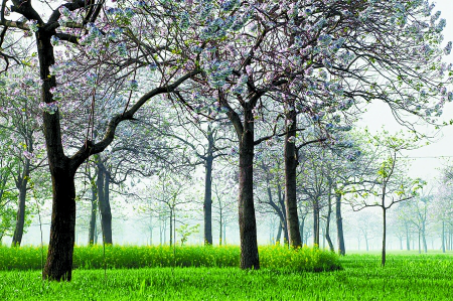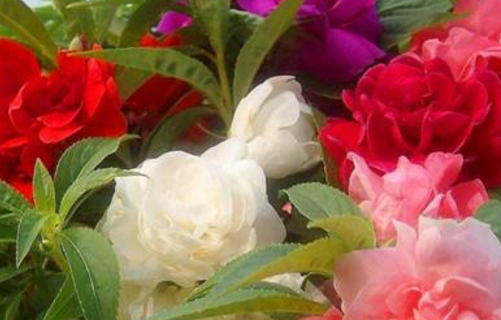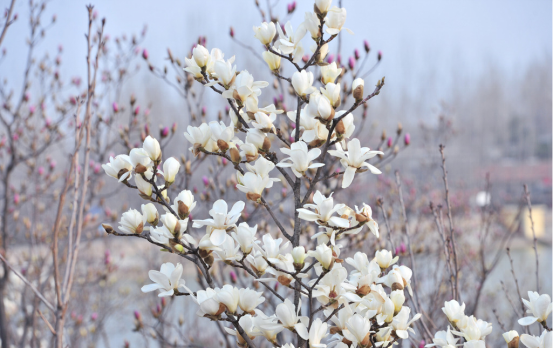Culture methods of paulownia
1. Light and temperature
As paulownia is a better variety to grow, it can be planted in sunny places. Like places with plenty of sun, have a strong ability to withstand drought, so you don't have to worry about not being watered for a long time. For temperature, paulownia likes to be in a warm place, so the temperature can be as low as minus 25 degrees Celsius and as high as 38 degrees Celsius. If it is too low, it is not conducive to the growth of paulownia.
2. Soil
For soil, paulownia will be relatively demanding. Like to grow in loose and fertile soil. The soil should not be too sticky or too hydrated, which will cause the roots of paulownia to rot, which is not conducive to growth. in addition, the soil is too dry, which will prevent paulownia from growing up.

The above is the difference between paulownia and sycamore, in fact, these two varieties are very easy to distinguish, more careful observation can be distinguished!
Culture methods and matters needing attention of paulownia
Culture methods of paulownia light and temperature
Paulownia likes sunny environment and is more resistant to shade. Paulownia has strong drought resistance, so keep the temperature at-25 degrees Celsius-38 degrees Celsius when breeding paulownia. If the temperature is below minus 25 degrees Celsius, you will suffer frost damage.
Soil
Paulownia has higher requirements for soil. It is mainly manifested in soil fertility, soil layer thickness and loose degree. If the soil is more sticky or too waterlogged, it will make paulownia grow poorly. Too dry soil will also make the growth momentum of paulownia poor.
Matters needing attention in paulownia culture diseases and insect pests
Paulownia pests are mainly big bag E, beetles, diseases are anthrax, black bean disease and so on. The main harm of beetles to paulownia is that larvae bite and eat seedlings in early spring. The main method of prevention and control is to manually kill or release poultry to eat them. Paulownia is the most suitable to be harmed by Plutella xylostella, which can be controlled by 3000mm 3200 times of enemy killing liquid. To control anthracnose and black bean disease, copper sulfate and ammonium bicarbonate can be mixed according to the ratio of 1:10, sealed for 24 hours, and the seedlings can be sprayed with 200x liquid.
Reproduction method
The main propagation methods of paulownia are root insertion, sowing, leaving roots and so on.
Flowering and fruiting stage
The flowering period of paulownia is from March to April and the fruit period is from September to October.
Culture methods and matters needing attention of paulownia tomentosa
Latin name Paulownia tomentosa
Also known as purple paulownia, Gangtong, Japanese paulownia
Binomial method Paulownia tomentosa (Thunb.) Steud.
The plant kingdom.
Phylum angiosperm
Dicotyledonous class
Subclass synpetalous flower
Eye-labial order
Department of Science and Metaphysics
Belong to paulownia
Paulownia Paulownia tomentosavar.tsinlingensis
The distribution area grows from 500m to 1800 m above sea level.
Variety of paulownia
Paulownia (scientific name: Paulownia tomentosa) belongs to the genus Paulownia of Scrophulariaceae. With its purple flowers, also known as purple paulownia. Deciduous trees, up to 20m high, with brownish-gray bark and white spots. Petiole often with sticky glandular hairs, leaves entire; lateral branches of Cymes underdeveloped, small Cymes with 3-5 flowers, calyx shallowly campanulate, densely stellate tomentose, 5-lobed to middle, Corolla funnelform-campanulate, outside lilac, hairy, inner surface white, with purple stripes; capsule ovoid, apex acute, exocarp leathery; florescence April-May; fruit August-September. Distributed in North America, Japan, Korea, Europe and Chinese mainland in Hebei, Shandong, Hubei, Jiangxi, Liaoning, Henan, Jiangsu, Anhui and other places, growing in areas ranging from 500 m to 1800 m above sea level.
1. Morphological characteristics.
Trees up to 20 meters tall, broad umbrella-shaped crown, brownish gray bark; branchlets with obvious lenticels, often with sticky short glandular hairs when young. Leaf blade heart-shaped, up to 40 cm long, apical acute, entire or undulate-lobed, upper hairs sparse, lower hairs dense or sparse, gray-brown dendritic hairs under old leaves often stipitate and 3-12 slender filiform branches, leaves on new branches larger, hairs often unbranched, sometimes with sticky glandular hairs; petiole often with sticky short glandular hairs. The lateral branches of inflorescence branches are underdeveloped, about half of the central main branch or slightly shorter, so the inflorescence is pyramidal or narrowly conical, generally less than 50 cm long, rarely longer, the total pedicel of Cymes is 1-2 cm long, almost as long as pedicels, with 3-5 flowers. Calyx shallowly campanulate, ca. 1.5 cm, villi not shed outside, divided to or split through middle, calyx teeth ovate-oblong, acute or slightly obtuse in flower to obtuse in fruit; Corolla purple, funnelform-campanulate, 5-7.5 cm long, arched about 5 mm from tube base, suddenly inflated upward, glandular hairy outside, inner surface glabrous, eaves 2 lips, ca. 5 cm in diameter; stamens up to 2.5 cm long. Ovary ovoid, with glandular hairs, style shorter than stamens. Capsule ovoid, densely mucilaginous glandular hairy when young, 3-4.5 cm long, persistent calyx not revolute, pericarp ca. 1 mm thick; seeds winged ca. 2.5-4 mm. The florescence is from April to May and the fruiting period is from August to September.
The species often varies in terms of dense coat, the size of flower branches and Corolla, and the obtuse tip of calyx teeth due to habitat and altitude. It grows at a higher altitude, and has the trend of smaller flower branches, blunt calyx teeth at flowering stage and slightly shorter Corolla.
2. Growth environment
It is resistant to cold and drought, salt and alkali, wind and sand, strong resistance, and has a wide range of adaptation to climate. The growth is affected when the high temperature is above 38 ℃, and the absolute lowest temperature is frozen when the temperature is-25 ℃. This species is more resistant to drought and barren, and is especially suitable in cold and arid areas in the north, but the trunk is low and the growth rate is slow.
3. Geographical distribution
Distributed in southern Liaoning, Hebei, Henan, Shandong, Jiangsu, Anhui, Hubei, Jiangxi and other places, usually cultivated, wild in the western region. It can reach 1800 meters above sea level. Japan, Korea, Europe and North America are also introduced and cultivated.
- Prev

Notice on the cultivation of Camellia impatiens
In the process of camellia cultivation, especially in the upper basin, we should pay attention to selecting loose, fertile and good drainage soil. And in the pot to wait until the seedlings grow well after the next! After reading these articles above
- Next

The production method of Magnolia bonsai
First of all, Magnolia bonsai can choose Magnolia magnolia and other rootstocks for grafting, and choose the sturdy branches of Magnolia magnolia as scions. The selection basin should choose purple sand pottery basin or glazed pottery basin, and put it in a sunny place. At the beginning, we should pay attention to remove the excess branches and leaves and reduce the transpiration of water.
Related
- Fuxing push coffee new agricultural production and marketing class: lack of small-scale processing plants
- Jujube rice field leisure farm deep ploughing Yilan for five years to create a space for organic food and play
- Nongyu Farm-A trial of organic papaya for brave women with advanced technology
- Four points for attention in the prevention and control of diseases and insect pests of edible fungi
- How to add nutrient solution to Edible Fungi
- Is there any good way to control edible fungus mites?
- Open Inoculation Technology of Edible Fungi
- Is there any clever way to use fertilizer for edible fungus in winter?
- What agents are used to kill the pathogens of edible fungi in the mushroom shed?
- Rapid drying of Edible Fungi

